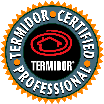Termite
Termites in the United States alone cause an estimated $5 billion per year in damages and repair. A large colony containing millions of Subterranean Termites can ingest up to 1 pound of wood per day. A colony this large may forage up to 300 feet. Subterranean Termites swarm during the day mainly from January through May, but may swarm at other times if conditions are right. When termites swarm, they are looking for places to start new colonies as part of the mating cycle.
Formosan Termites are now in St. Augustine. Smith Bros. Pest Control is proud to have successfully treated and eliminated the first case of Formosan Termites in St. Johns county.
 |
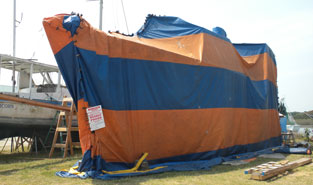 |
Formosan Termites are one of the most aggressive termites in the world. The average size of a mature colony is 8.5 million termites. With a Formosan Termite queen laying 2000 eggs a day, it takes 3-5 years for a colony to mature. The average colony consumes mare than 1000 pounds of wood per year. The largest Formosan Termite nest was found in Louisiana and contained 70 million termites. The nest itself weighed in at 600 lbs.
We have developed a specialized treatment plan specifically for Formosan Termites. This consists of multiple methods of treatment. The only way to be sure of 100% elimination of Formosan Termites is through a liquid spray, foam treatment and tent fumigation.
Termites vs Ants
Subterranean Termite swarmers are frequently mistaken for Ant swarmers. As seen in the picture below, Ants have a pinched waste, while Termite swarmers have cigar shaped bodies.
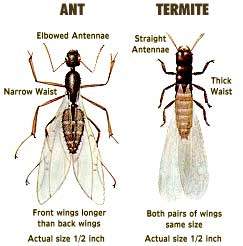 |
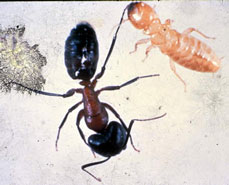 |
Subterranean Termite Damage vs Drywood Termite Damage
Another common point of confusion is the difference between Subterranean Termites and Drywood Termites. The easiest way to tell the difference between the two, is to look at the damage. Below are examples of Drywood and Subterranean Termite damage. Notice that the Drywood damage is smooth, taking on the appearance of sanded wood. Subterranean damage is very dirty, with a large amount of dirt making up their mud tubes. Subterranean Termites require ground contact. Drywood Termites however, need no ground contact. Also Drywood Termites produce numerous pellets, as seen in the picture below whereas Subterranean Termites do not.
 |
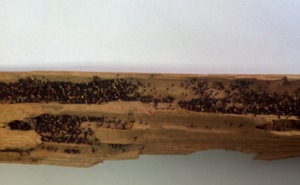 |
If your home or property is infested with Subterranean Termites, we offer treatments designed to eliminate existing colonies and help prevent future infestation. We inspect your house regularly for any signs of termites
Are you sure you have Subterranean Termites? You may have Drywood Termites. Check our FUMIGATION page for more information about Drywood Termites and our proven method of 100% elimination.
Licensed, Bonded and Insured
Serving St. John’s County and surrounding areas
